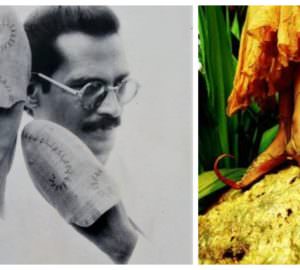Time does fly. Time is no friend to man. Timing is everything. So we hear… but make it your mate and watch it expand a timelessness that stretches at its threads, allowing you to come dance with its secrets.
The magical maverick genius of our times, David Bowie, I’m guessing, knew this only too well. With eccentric art-fullness, pop-rock’s spaceman pealed each layer of skin to self mould into another version of his personal re-invention. Create, destroy, reinvent. “We are nothing, but a Blackstar,” Bowie said.
 David Bowie to the world was a gender-blender of mind, mood and spirit. Ziggy Stardust to those conflicted with sexuality, Aladdin Sane to the thin-line closet walker, The Thin White Duke snub-nosing conventional lyric, song-writing and society inspiring fashion lines across the planet, and ushering androgyny. Each persona a careful study of personality, wringing out as much content and colour from it and then sealing it forever to history. And just when exhaustion hits, a regular white dude in a regular white sounding band with the Tin Machine. Critics eulogized his soul searching attempt with the move to `belong,’ or, was it recuperation from sheer solo burn out? `Crack City,’ (1989) “Oh come all you children. Don’t grab that scabby hand, It belongs to Mr. Sniff and Tell,” summing up his heady days of coke sniffing, drugs, rock and an LA roller-coaster life of fame and infamy. An attempt at self-beating analysis, with the often repeated word `nothing,’ (for those lyric hunters), which peppers and punctuates Bowie’s substantial body of work. “Hold on to nothing” from `The Man Who Sold the World,’ (1970), through `Diamond Dogs’ (1974) and the refrain “We’re nothing and nothing can help us,” from `Heroes’ (1977) and onward all the way to `Blackstar’ (2016). Then more with `Sacrifice Yourself’ (1989). “There it is, the look, the winner you once talked of being. Give her one last kiss and dive right out the window screaming”…Bowie was addictive. Even as a nine-year-old, his teachers remember him as “strikingly imaginative,” “vividly artistic” and “astonishing” for a child. There was simply no running away from this man.
David Bowie to the world was a gender-blender of mind, mood and spirit. Ziggy Stardust to those conflicted with sexuality, Aladdin Sane to the thin-line closet walker, The Thin White Duke snub-nosing conventional lyric, song-writing and society inspiring fashion lines across the planet, and ushering androgyny. Each persona a careful study of personality, wringing out as much content and colour from it and then sealing it forever to history. And just when exhaustion hits, a regular white dude in a regular white sounding band with the Tin Machine. Critics eulogized his soul searching attempt with the move to `belong,’ or, was it recuperation from sheer solo burn out? `Crack City,’ (1989) “Oh come all you children. Don’t grab that scabby hand, It belongs to Mr. Sniff and Tell,” summing up his heady days of coke sniffing, drugs, rock and an LA roller-coaster life of fame and infamy. An attempt at self-beating analysis, with the often repeated word `nothing,’ (for those lyric hunters), which peppers and punctuates Bowie’s substantial body of work. “Hold on to nothing” from `The Man Who Sold the World,’ (1970), through `Diamond Dogs’ (1974) and the refrain “We’re nothing and nothing can help us,” from `Heroes’ (1977) and onward all the way to `Blackstar’ (2016). Then more with `Sacrifice Yourself’ (1989). “There it is, the look, the winner you once talked of being. Give her one last kiss and dive right out the window screaming”…Bowie was addictive. Even as a nine-year-old, his teachers remember him as “strikingly imaginative,” “vividly artistic” and “astonishing” for a child. There was simply no running away from this man.
 I met Bowie in a flash of screaming hormones seeking defiant self expression. `Let’s Dance’ (1983) he said to me, ”Put on your red shoes and dance the blues. Sway through the crowd to an empty space.” His highest selling track with an smashing guitar solo by Stevie Ray Vaughan became a pop box office anthem for the radicals. We were those children dancing with electricity coursing through our veins. Young men and women of our generation, gob-smacked in their faces, and with it a universe that was all our very own. Bowie made us believe we could be whoever we chose to be. We could love men or chose to love women, or both, together. It was the mood of the times and we were all willing to offer our lives and passions to its altars. And so it was. A storm further fanned when MTV claimed our teenage sanity. But clearly as a young woman born in a country of Eastern censorship of the Middle East, I had missed out on the early influences of Ziggy’s stardust spicing up my own imagination. Instead, fast-forwarding straight into this very bohemian gentleman who cross-dressed rather fancy, had hair gelled stiff backwards or a spiked bright, with a flamboyant flair for throwing in a blink flowing trench coats and jackets that were Vivienne Westwood and Zandra Rhodes.
I met Bowie in a flash of screaming hormones seeking defiant self expression. `Let’s Dance’ (1983) he said to me, ”Put on your red shoes and dance the blues. Sway through the crowd to an empty space.” His highest selling track with an smashing guitar solo by Stevie Ray Vaughan became a pop box office anthem for the radicals. We were those children dancing with electricity coursing through our veins. Young men and women of our generation, gob-smacked in their faces, and with it a universe that was all our very own. Bowie made us believe we could be whoever we chose to be. We could love men or chose to love women, or both, together. It was the mood of the times and we were all willing to offer our lives and passions to its altars. And so it was. A storm further fanned when MTV claimed our teenage sanity. But clearly as a young woman born in a country of Eastern censorship of the Middle East, I had missed out on the early influences of Ziggy’s stardust spicing up my own imagination. Instead, fast-forwarding straight into this very bohemian gentleman who cross-dressed rather fancy, had hair gelled stiff backwards or a spiked bright, with a flamboyant flair for throwing in a blink flowing trench coats and jackets that were Vivienne Westwood and Zandra Rhodes.
 The cult of Bowie inspired five decades of avant garde, a fashion innovator as much as a musical vanguard. Flashing a career from 1962-2016 spiked with raised eyebrows, David Bowie curated his own master-class. And what a class apart he was. Everything that he wore screamed`British Bitch’ of the late 60s epitomizing androgyny, cultural diversity and glam rock. Plummeting each decade after decade into a fashion frenzy, all the time weaving sexual fluidity, creating and rejecting his own self created `spiders from Mars’ (The Rise and Fall of Ziggy Stardust and the Spiders from Mars, 1972), defying common sense, and then suddenly embracing it, lest he sweeps under the pressure of his own aura. Bowie’s self explorations in Berlin (1976-79) with the`Berlin Triology’ marks his incessant self quests.
The cult of Bowie inspired five decades of avant garde, a fashion innovator as much as a musical vanguard. Flashing a career from 1962-2016 spiked with raised eyebrows, David Bowie curated his own master-class. And what a class apart he was. Everything that he wore screamed`British Bitch’ of the late 60s epitomizing androgyny, cultural diversity and glam rock. Plummeting each decade after decade into a fashion frenzy, all the time weaving sexual fluidity, creating and rejecting his own self created `spiders from Mars’ (The Rise and Fall of Ziggy Stardust and the Spiders from Mars, 1972), defying common sense, and then suddenly embracing it, lest he sweeps under the pressure of his own aura. Bowie’s self explorations in Berlin (1976-79) with the`Berlin Triology’ marks his incessant self quests.
From Jean Paul Gaultier – who quotes Bowie’s influence on him as `instant and permanent,’ — to Emilio Pucci who showcased a dedication of jewel bright suits in 2012, Burberry’s tribute to `Space Oddity’ (1969), no one artist has had the singular minded ability to trapeze right through 1980-88 (new wave and pop rock era, the `New Romantic’ period) to 2016, straddling glam rock, electronica, neo-classical with virtuoso complexity in between. “All the world’s a dude” Bowie lived and believed, as men and women embraced a cultural fabric that Bowie stood tall holding the flag and light for the times to come. Well-known for adopting many elements of Japanese culture into his stage performances, Japanese designer Kansai Yamamoto – who designed much of Bowie’s celebrated Ziggy stage outfits – called him a `beautiful androgynous shape-shifter,’ who broke one sexual taboo after another with this infectious style. Among Yamamoto’s another famous Bowie outfit was one of my favourite, `Space Samurai,’ adapting loose trousers which samurais wore and are still part of martial arts tradition.

With such a long and varied career, Bowie settled into an `elderly gentleman’ of the 2000s post the euphoria of Live Aid, his world concert tours exploring his music artistry and astounding his peers. In his own admission, he wrote songs about Bob Dylan and John Lennon, as also artist Andy Warhol seeing their influences and reflecting in his music and art, Hunky Dory (1971), `Andy Warhol,’ `Song for Bob Dylan.’ Bowie himself went on to inspire innumerable bands across the planet, as they drew heavily from his signature sounds, stage persona to individual style.
Notwithstanding `The Next Day’ (2013) with `Where Are We Now?’ a haunting tune that stayed with me for many days on repeat loop, Bowie signed off with `Blackstar’ (2016) with lyrics deeply reading almost of a farewell and seeing his own end coming fast at him. The Man Who Fell to Earth (1976) and turned into Jareth, the Goblin King of Labyrinth (1986), Bowie signed off quickly, painlessly following rumored six heart attacks during his lifetime and a long battle with cancer. He had no minutes to waste, no tears to shed, leaving behind a history so vast it would take another lifetime to emulate his hugely successful personality. So long Ziggy. Let your Stardust continue to shine on all of us…
Sharing this tribute video which I thought was pretty cool.
Above article was first featured in Goa Streets Entertainment Weekly



